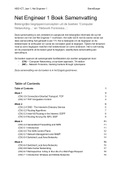Samenvatting
HBO-ICT, Jaar 1, Net Engineering 1, Boek Samenvatting
Belangrijke begrippen/concepten uit de boeken ‘Computer Networking…’ en ‘Network Forensics...’. Deze samenvatting is ook verbeterd en aangevuld met belangrijke informatie die op het tentamen van het vak Net Engineering 1 voorkwam. Het cijfer dat ik met deze samenvatting heb gehaald i...
[Meer zien]





